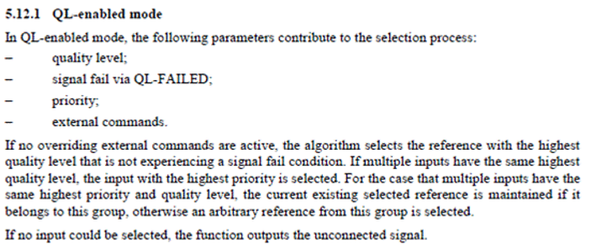What is Synchronisation Selection?
An EEC may have multiple sources of a SyncE reference. It needs to decide which of these to use.
Do the standards define what the selection algorithm should be?
G.8264 Annex A describes the requirements for the selection mechanism but does not suggest an algorithm or implementation.
G.781 Annex A has a detailed description of the selection algorithm. This specifies the behaviour of the selection mechanism without suggesting an implementation.
G.781 Clause 5.12.1 describes the algorithm in general terms:
In simple terms, this comes down to “Traceability, Availability, Priority”
- Traceability: look for the highest QL level, as this is traceable to the highest quality source
- Availability: is the signal in signal fail or not?
- Priority: the tiebreaker, locally assigned priority on input.
If SyncE is being received but there is no ESMC, how does this impact synchronisation selection?
G.8264 Clause 10.2 describes two modes of operation:
- Non-synchronous:
A synchronous Ethernet interface configured in non-synchronous mode is an interface that, for the receive side, does not pass the recovered clock to the system clock and is therefore not a candidate reference to the synchronization selection process - Synchronous:
A synchronous Ethernet interface can be configured in synchronous operation mode.
Its receive side is able to extract the frequency of its input signal and pass it to a system clock (an EEC or better quality clock). It processes the ESMC and extracts the QL. This signal can now be used as a candidate frequency reference
In other words, in a network in which physical syntonisation is required, a clock generating SyncE but with no ESMC should not be considered as a reference source.
The rationale for this is that if there is no ESMC, it might just be a standard Ethernet link with an untraceable 100ppm oscillator. The only thing that tells you this is synchronous is the ESMC.
Therefore, while G.781 talks about “QL-enabled” and “QL-disabled” modes, there is no such thing for SyncE.
The use of QL-disabled comes from SONET/SDH, where some operators ran without QL, but knowing that the links were synchronous anyway. Effectively that meant they “fixed” the primary and failover paths using priority. You can’t do that with SyncE, because the link might not be synchronous at all.

